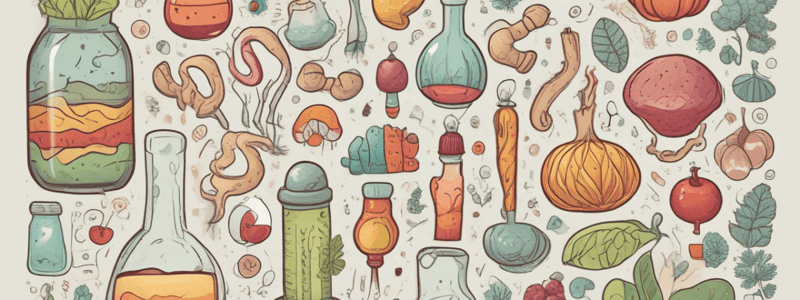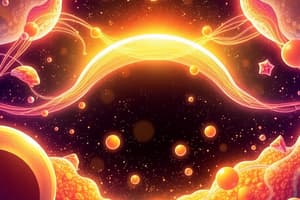Podcast
Questions and Answers
What is the general formula for carbohydrates?
What is the general formula for carbohydrates?
- CnH2nOn
- CnH2n+2On
- C(H2O)n
- Cn(H2O)n (correct)
Which of the following is NOT a monosaccharide?
Which of the following is NOT a monosaccharide?
- Sucrose (correct)
- Galactose
- Glucose
- Fructose
Which monosaccharide is a component of RNA and DNA?
Which monosaccharide is a component of RNA and DNA?
- Ribose (correct)
- Fructose
- Galactose
- Glucose
Which of the following is NOT a function of carbohydrates in the body?
Which of the following is NOT a function of carbohydrates in the body?
Which type of carbohydrate is considered the building block of all carbohydrates?
Which type of carbohydrate is considered the building block of all carbohydrates?
Which of the following is a hexose sugar?
Which of the following is a hexose sugar?
Which of the following is a disaccharide?
Which of the following is a disaccharide?
Which of the following statements is TRUE about monosaccharides?
Which of the following statements is TRUE about monosaccharides?
What type of monosaccharides contains an aldehyde group?
What type of monosaccharides contains an aldehyde group?
Which of the following is the mother compound of aldoses?
Which of the following is the mother compound of aldoses?
Which disaccharide is not considered reducing?
Which disaccharide is not considered reducing?
What is the general structure of ketoses characterized by?
What is the general structure of ketoses characterized by?
Oligosaccharides are defined as polymers of how many monosaccharide units?
Oligosaccharides are defined as polymers of how many monosaccharide units?
Which enzyme hydrolyzes lactose into glucose and galactose?
Which enzyme hydrolyzes lactose into glucose and galactose?
Which type of polysaccharides are built from more than 10 monosaccharide units?
Which type of polysaccharides are built from more than 10 monosaccharide units?
Which example represents a ketose?
Which example represents a ketose?
Flashcards
Carbohydrates
Carbohydrates
The most abundant organic molecules in nature, composed of carbon, hydrogen, and oxygen with a ratio of 1:2:1.
Polysaccharide
Polysaccharide
A complex organic molecule made up of multiple sugar units linked by glycosidic bonds.
Monosaccharide
Monosaccharide
The simplest form of carbohydrates, containing only one sugar unit.
Disaccharide
Disaccharide
Signup and view all the flashcards
Aldose
Aldose
Signup and view all the flashcards
Ketose
Ketose
Signup and view all the flashcards
Glucose
Glucose
Signup and view all the flashcards
Galactose
Galactose
Signup and view all the flashcards
Fructose
Fructose
Signup and view all the flashcards
Mannose
Mannose
Signup and view all the flashcards
Glycosidic Linkage
Glycosidic Linkage
Signup and view all the flashcards
Sucrose
Sucrose
Signup and view all the flashcards
Lactose
Lactose
Signup and view all the flashcards
Maltose
Maltose
Signup and view all the flashcards
Starch
Starch
Signup and view all the flashcards
Glycogen
Glycogen
Signup and view all the flashcards
Study Notes
Carbohydrates
- Carbohydrates are the most abundant organic molecules in nature, formed of carbon, hydrogen, and oxygen atoms with a ratio of 1:2:1 and the general formula Cn(H2O)n.
- They are organic substances (polyhydroxy aldehyde or ketone) and most names for sugars end in -ose.
Biomedical Importance of Carbohydrates
- Carbohydrates are the chief source of energy for most organisms.
- They act as a storage form of energy in the body.
- They serve as cell membrane components that mediate some forms of intercellular communication.
- Ribose and deoxyribose sugars form part of the structure of RNA and DNA.
- Major antigens are carbohydrates in nature, e.g., blood group substances.
Classification of Carbohydrates
- Carbohydrates are classified according to the hydrolysis products (number of individual simple units) into:
- Monosaccharides: contain 1 sugar unit (cannot be hydrolyzed), e.g., Glucose, galactose, mannose, and fructose.
- Disaccharides: contain 2 sugar units, e.g., Maltose, lactose, and sucrose.
- Oligosaccharides: contain 3-10 sugar units.
- Polysaccharides: contain more than 10 sugar units, e.g., Starch, glycogen, and cellulose.
Monosaccharides
- Monosaccharides are the simplest units of carbohydrates and the building blocks.
- The general formula is (CH2O)n, so the name of carbohydrates (carbon + H2O).
- The ratio between carbon and H2O is 1.
- Most monosaccharides occurring in mammals are D sugars.
- Examples of monosaccharides include Glucose, mannose, galactose, and fructose.
Classification of Monosaccharides
- Classification based on the number of carbon atoms:
- Trioses: contain 3 carbon atoms.
- Tetroses: contain 4 carbon atoms.
- Pentose: contain 5 carbon atoms.
- Hexoses: contain 6 carbon atoms.
- Classification based on the functional group:
- Aldoses: monosaccharides containing an aldehyde group (-CH=O), e.g., Glyceraldehyde, erythrose, ribose, glucose, galactose, and mannose.
- Ketoses: monosaccharides containing a ketone group (-C=O), e.g., Dihydroxyacetone, erythrulose, ribulose, and fructose.
Disaccharides
- Disaccharides consist of two monosaccharides united together by glycosidic linkage.
- Disaccharides are classified into reducing disaccharides and non-reducing disaccharides.
- Examples of disaccharides include:
- Sucrose (non-reducing): hydrolyzed by sucrase enzyme into Glucose + Fructose.
- Lactose (reducing): hydrolyzed by lactase enzyme into Galactose + Glucose.
- Maltose (reducing): hydrolyzed by maltase enzyme into 2 Glucose.
Oligosaccharides and Polysaccharides
- Oligosaccharides are polymers of 3-10 monosaccharide units and are not an important source of carbohydrates in the diet for humans.
- Polysaccharides are composed of more than 10 monosaccharide units linked by glycosidic bonds and are non-reducing.
- Examples of polysaccharides include Starch, glycogen, and cellulose.
Studying That Suits You
Use AI to generate personalized quizzes and flashcards to suit your learning preferences.




